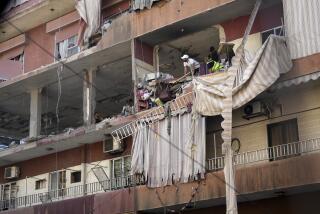Point: A Strong Military for a Dangerous World : Somalia and Haiti are among the known trouble spots. Then there are terrorists with nuclear capability.
- Share via
Generals at the Pentagon and diplomats at the State Department cringe at the mention of maintaining a strong national defense in this era of “downsizing” military forces. But they go catatonic at the mention of nuclear, biological and chemical proliferation, areas in which they have few answers and a declining ability to act.
An overconfidence in the public’s attitude toward defense has emerged, perhaps because of relatively painless military victories as in Grenada, Panama, the Gulf War and the gradual triumph in the Cold War. Nevertheless, threats to America are expanding at a quantum rate. The public remains oblivious because the threats are not highlighted by media or governmental elites. Serious threats are being whisked aside by those in power so as not to disturb this imaginary era of peace.
The world remains a dangerous place. In any 12-month period since 1945, there were between 35 and 38 conflicts of various levels of intensity. In the past 12-month cycle, there were 62. This escalation in violence is due in part to the crumbling of the former Soviet Union, the growth of religious fundamentalism and ethnocentrism worldwide and a contracting of the world economy. The conflicts range from regional wars to numerous guerrilla conflicts and terrorist activities. Any particular conflict could threaten vital U.S. interests, such as access to markets and natural resources, transit lanes, even the safety of our citizens abroad. Protecting these interests could necessitate everything from special operations to large-scale U.S. military responses.
During the Gulf War of 1990-91--before substantial cutbacks--the military had to cannibalize units of personnel, equipment and ammunition. Even so, U.S. costs of operation and combat shot to about $55 billion for Desert Storm. Meanwhile, the military’s efforts in the drug war and other deployments abroad slowed considerably. Had America faced another serious challenge, we would have been pressed.
Under President Clinton’s current defense budget, troop strength will be cut from 2.1 million before the Gulf War to 1.4 million by 1997. The Army will have 10 active divisions instead of 14. The Air Force would lose eight of its 28 fighter wings. The Navy would shrink from 440 ships with 14 aircraft carriers to 340 ships with 12 aircraft carriers. All told, defense spending would go from $302 billion in 1990 to roughly $233 billion by 1997. Defense capabilities cut now would cost four to 10 times more to replace. This would leave a hollow military unable to meet an expanding array of threats--and would invite future contests against us.
We now face multiple-deployment scenarios from Somalia to Macedonia to Haiti, and there is no end in sight. The dangers posed by future imbroglios are multiplied a thousandfold when considered in light of recent trends in nuclear, biological and chemical weapons proliferation. The problems in the former Soviet Union have created a situation in which more than 30,000 nuclear weapons and hundreds of thousands of biochemical devices are beyond the control of any “sane” individual or group. Errant factions practicing “dark-side capitalism” have illegally sold fissionable material--possibly weapons and certainly technology.
Military conflict between combatants armed with weapons of mass destruction, such as India and Pakistan, Israel and the Arab states, even China, possibly against Vietnam, Taiwan or the Philippines in the Spratly Islands scenario, would generate vast international turmoil. It would jeopardize the world economy and harm the health and safety of our planet. America could be drawn into these conflicts involving weapons of mass destruction, confronting nations such as North Korea and Iran, because we are the “sole superpower.”
Additionally, the current pace of proliferation means that incidents of nuclear, chemical and biological terrorism are possible any time. Terrorist acts such as the bombing of the World Trade Center in New York would be dwarfed by the impact of a nuclear, chemical or biological weapon released by a terrorist entity.
These threats are being exacerbated by the actions of our government. Under the Bush Administration, downsizing was unwisely started before the Gulf War. Now, the White House is conducting a “top-down” review of America’s security requirements by continuing this predominantly budget-driven downsizing of the military. Defense Secretary Les Aspin provided damning evidence of this when he told the House Armed Services Committee that the defense budget should be heavily influenced by “macroeconomics,” rather than “threat perceptions.”
The committee chairman, Ronald Dellums (D-Oakland), wanted to cut the defense budget even more deeply. This, on the erroneous reasoning that with the demise of the Soviet Union, the United States no longer faces any substantial security threat.
What is necessary in today’s environment is not the downsizing of the U.S. military, but reconfiguring, even upgrading existing strength to deal with current and future threats.
Recent and Current Armed Conflicts
Europe and the former Soviet Union
1. Armenia and Azerbaijan: Conflict over Nagorno-Karabakh.
2. Bosnia-Herzegovina: Ethnic warfare among Serbs, Croats and Muslims.
3. Croatia: Ethnic/land warfare with Serbs.
4. Cyprus: Ethnic conflict between Greeks and Turks.
5. Georgia: Ethnic warfare against Abkhazians and South Ossetians.
6. Moldova: Territorial warfare against Russians and Ukrainians.
7. Russia: Dispute between North Ossetia and Chechenya.
8. Spain: Terrorism.
9. Tajikistan: Civil war between government and fundamentalist Muslims.
10. United Kingdom: IRA and sectarian violence.
Sub-Saharan Africa
14. Djibouti: Ethnic conflict.
15. Ethiopia: Ethnic insurgencies.
16. Liberia: Civil war.
17. Mali: Insurgency by Tuareg tribe.
18. Mozambique: Insurgency.
19. Niger: Tuareg insurgency.
20. Nigeria: Resistance to military rule.
21. Rwanda: Tribal conflicts and border conflict with Uganda.
22. Senegal: Separatist insurgency.
23. Sierra Leone: War with Liberian rebels.
24. Somalia: Clan-based civil war; foreign involvement.
25. South Africa: Political and racial violence.
26. Sudan: Civil war; border conflict with Egypt.
27. Uganda: Insurgency in northern districts.
28. Zaire: Ethnic violence.
Middle East
29. Afghanistan: Civil war.
30. Algeria: Muslim fundamentalist insurgency, terrorism.
31. Bahrain/Qatar: Territorial dispute.
32. Egypt: Muslim fundamentalist terrorism.
33. Iraq: Ethnic conflicts with Kurds and Shiite Muslims.
34. Israel: Palestinian insurgency.
35. Lebanon: Ethnic warfare between Israelis and Hezbollah and other Arab terrorist groups.
36. Turkey: Kurdish insurgency.
South Asia and the Pacific Rim
37. Bangladesh: Insurgency.
38. Bhutan: Ethnic unrest.
39. Burma: Insurgencies, ethnic conflicts and drug violence.
40. Cambodia: Khmer Rouge civil war; foreign involvement.
41. India: Ethnic violence among Hindus, Muslims and Sikhs.
42. Indonesia: Insurgency and ethnic conflict.
43. Laos: Insurgency by Hmong Lao, drug violence.
44. Pakistan: Border conflict with India over Kashmir.
45. Papua New Guinea: Insurgency.
46. Philippines: Insurgency.
47. South Korea: Border infractions with North Korea.
48. Sri Lanka: Tamil ethnic insurgency.
49. Thailand: Civil unrest and drug violence.
Central and South America
50. Bolivia: Guerrilla insurgencies.
51. Brazil: Drug violence.
52. Colombia: Insurgency, terrorism and drug violence.
53. Ecuador: Border conflict with Peru.
54. El Salvador: Drug violence and banditry by former soldiers and guerrillas.
55. Guatemala: Guerrilla insurgencies.
56. Haiti: Unresolved coup.
57. Honduras: Insurgency.
58. Mexico: Drug violence.
59. Nicaragua: Insurgencies by former Contras and Sandinistas.
60. Panama: Drug violence.
61. Peru: Shining Path insurgency, drug violence.
62. Venezuela: Drug war on Colombian and Brazilian borders.
Source: National Defense Council Foundation
More to Read
Sign up for Essential California
The most important California stories and recommendations in your inbox every morning.
You may occasionally receive promotional content from the Los Angeles Times.













